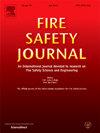在基于性能的消防安全设计中采用基于航点的能见度方法
IF 3.4
3区 工程技术
Q2 ENGINEERING, CIVIL
引用次数: 0
摘要
在基于性能的消防安全设计中,确保安全出口(如安全标志的可见度)是一个重要的安全目标。通常通过模拟烟雾扩散来证明是否符合建筑要求。火灾动力学模拟器等数值模型通常使用光消光系数将能见度作为局部数量进行计算,而不考虑安全标志的实际光路。这里引入了能见度地图,为火灾模拟数据的后期处理提供了一种方法。能见度图根据能见度标示出逃生路线上的安全区域。在每个位置,可用能见度都是通过金的经验关系计算出来的,即沿着最近出口标志的视线的消光系数的综合值。所需的能见度来自这些点之间的距离。此外,还考虑了视角或视觉障碍物等其他参数。所提出的方法可用于时间能见度评估,例如在 ASET-RSET 分析中。本文章由计算机程序翻译,如有差异,请以英文原文为准。
A waypoint based approach to visibility in performance based fire safety design
In performance based fire safety design, ensuring safe egress, e.g. by visibility of safety signs, is a crucial safety goal. Compliance with the building requirements is often demonstrated by simulations of smoke spread. Numerical models like the Fire Dynamics Simulator generally compute visibility as a local quantity using the light extinction coefficient, without the consideration of the actual light path to a safety sign. Here, visibility maps are introduced, providing an approach for post-processing fire simulation data. They indicate safe areas along egress routes, with respect to visibility. At each location, the available visibility is calculated using Jin’s empirical relation, as an integrated value of the extinction coefficient along the line of sight to the closest exit sign. The required visibility results from the distance between those points. Additional parameters like view angle or visual obstructions are considered. The presented method allows for temporal visibility assessment, e.g. in an ASET-RSET analysis.
求助全文
通过发布文献求助,成功后即可免费获取论文全文。
去求助
来源期刊

Fire Safety Journal
工程技术-材料科学:综合
CiteScore
5.70
自引率
9.70%
发文量
153
审稿时长
60 days
期刊介绍:
Fire Safety Journal is the leading publication dealing with all aspects of fire safety engineering. Its scope is purposefully wide, as it is deemed important to encourage papers from all sources within this multidisciplinary subject, thus providing a forum for its further development as a distinct engineering discipline. This is an essential step towards gaining a status equal to that enjoyed by the other engineering disciplines.
 求助内容:
求助内容: 应助结果提醒方式:
应助结果提醒方式:


